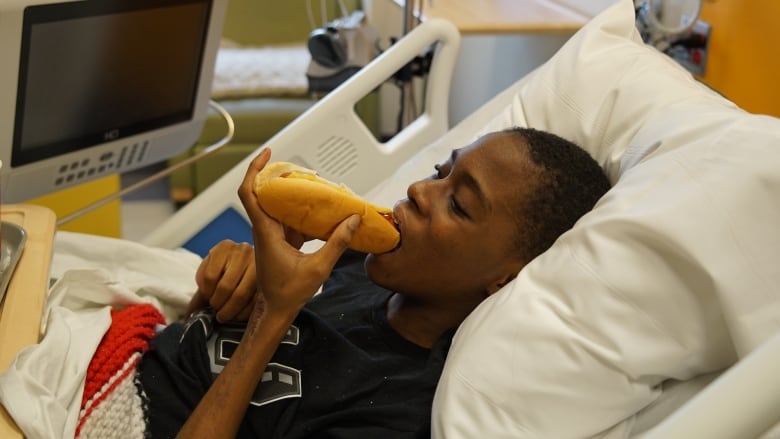How bringing room service to hospitals can help patients heal

Originally published on January 26, 2019
It's not uncommon for people to complain about bland, unappetizing hospital food. But a growing number of hospitals in Canada are pushing back against this stereotype, overhauling menus to be locally sourced and delicious.
Patients in hospital need to eat nutritious food to heal. Yet research suggests that 51 per cent of young children admitted to hospital in one study lost weight, as did nearly 45 per cent of adultpatients.
Some are too sick to eat. Many others leave the food tray untouched, leading to about 1.3 kilograms of food per bed to be thrown out each day. By one Canadian estimate, about half of the food placed at patients' bedsideswent towaste.
Joshna Maharaj is a chef and food activist with Take Back The Tray. Shehelped to transform the patient menu at Scarborough Hospital, as well as caf offerings for parents and visitors at Sick Kids in Toronto.
The meals went from what she called the "miserable monochrome" of processed foods, to scratch-made, local meals prepared in house.

One of her first changes was to toss toast.
"It cannot escape the sweaty dome," Maharaj told CBC Radio's White Coat, Black Art. "Infection control means everything has to be covered when it leaves the kitchen and goes into the germy space of the hospital. No piece of toast will survive."
That dome, usually plastic, traps in steam fromwarm food,takingtoast from crispy to soggy in a matter of minutes.Maharaj's solution was to serve a frittata instead.
"You pull the eggs out just before they're done and that extra bit of steam should let it arrive to the patient in reasonably good shape. We did the frittata the next morning to everybody's delight."
Maharaj solicited recipe ideas from food service staff at the hospital, resulting in more diverse dishes, such ascongee, a popular Asian porridge, and rice and daal, a staple in India.
"This is what convalescing food is in these cultures,so we rebuilt the menu with no end to painstaking detail," she said.
An apple a day
Maharajalso hasone simple tip for hospital officials who wish to improve the food they serve: Put an apple on the tray.
It's an encouraging visual for patients, emotionally and physically, as well as offers a touch of hospitality she said is often missing from hospitals.
Patients may complain about how difficult it is to heal from surgerywhen they're often served unappetizing and salty fare. But at one hospital in Ottawa, the menus and a 20-minute delivery guarantee are garnering positive reviews.
At the Children's Hospital of Eastern Ontario (CHEO), fresh food from a sautstation is now incorporated into the menus for patients, said Bernice Wolf, a registered dietitian and the facility's director of food and marketed services.
Also at 2 months I was stuck in the hospital with the twins for almost 2 weeks. We were in an isolation room so we were not allowed to leave. Even though I was the main source of food for both of them, they were not allowed to give me meals. I lived on toast, jello and water.
—@MKC_MEDIC"We promote healthier choices," Wolf said. "We encourage once a day for chocolate milk or higher fat foods. But we have them on the menu because kids are picky eaters. We want them to have some nourishment while they are here."
To keep childrensatisfied with their meal trays, Wolf said she updates the menu based onrising food trends, such as butter chicken, stir-fries and hoisin beef.
Cultivating culinary medicine
Hospitals aren't the only institutions making the link between food and health.
The University of Toronto's medical school renewed its curriculum in 2016 to promote "lifestyle medicine," which includes healthy habits such as eating nutritious food, engaging in physical activity, quitting smoking and reducing stress.
Culinary medicine applies the healthy living approach in the kitchenfor both patients and physicians, who are encouraged to act as role models.
Some customer feedback for our amazing chef @SimonWiseman and the dedicated @CHEOhospital kitchen crew. Duly noted! #LettersWeGetLetters #ChildrenTellTheTruth pic.twitter.com/m682ZxAehg
—@AlexMunter_One of the first assignments under thenew U of T lesson planincluded a cooking class at a grocery store, where first-year medical students learned to prepare meals like lentil burgers and a brusselssprouts salad.
'We've got to find a spot in the curriculum'
"We launched the curriculum and the second-year students who weren't in the new foundations curriculum, they heard about it," recalled Dr. John Sievenpiper, aphysician in the division of endocrinology and metabolism at St. Michael's Hospital.
"They were so excited by what they heard, they demanded that they get the same things. The leadership came and said 'Well, we've got to find a spot in the curriculum. You guys have to do this for the second years now.'"
Sievenpiper, who is also an associate professor of nutritional sciences at U of T, said that lifestyle medicine was previously just given "lip service." Medical learners were told of its importance without actually seeing how physicians could guide patients to put it into practice.
He's quick to acknowledge the university isn't the first to introduce the idea. In the U.S., Harvard's School of Public Health, Tulane University and the Culinary Institute of America all have similar programs.
As for Chef Maharaj, sheis invitingdoctors and dietitians to join her in championing better food both in and outside of hospitals.
"I've seen some doctors who do lovely thingsand start prescribing family meals at the table, or two weeks of not eating anything that came in package, which is a beautiful place to start," she said.
"Food lies in the heart of a preventative approach."












_(720p).jpg)


 OFFICIAL HD MUSIC VIDEO.jpg)
.jpg)



























































































